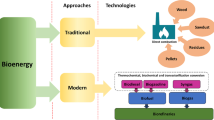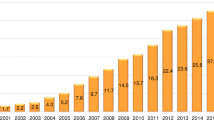Abstract
Biomass, one of the most important renewable energies, is playing and will continue to play an important role in the future energy structure of the world. This article aims to analyze the position and role, assess the resource availability, discuss the geographic distribution, market scale and industry development, and present the policy options of biomass in China. The resource availability and geographical distribution of biomass byproducts are assessed in terms of crop residues, manure, forest and wood biomass byproducts, municipal waste and wastewater. The position of biomass use for power generation is just next to hydropower among types of renewable energy in China. The potential quantity of all biomass byproducts energy in 2004 is 3511 Mtce (Mtce is the abbreviation of million tons of coal equivalents and 1 Mtce is equal to106 tce.), while the acquirable quantity is 460 Mtce. Biomass energy plays a critical role in rural regions of China. The geographical distribution and quantity of biomass byproducts resources depends mainly on the relationship between ecological zones and climate conditions. Our estimation shows that the total quantity of crop residues, manure, forest and wood biomass byproducts, municipal waste and wastewater resources are 728, 3926, 2175, 155 and 48240 Mt (million tons), respectively. Crop residues come mainly from the provinces of Henan, Shandong, Heilongjiang, Jilin and Sichuan. All manure is mainly located in the provinces of Henan, Shandong, Sichuan, Hebei and Hunan. Forest and wood biomass byproducts are mainly produced in the provinces or autonomous regions of Tibet, Sichuan, Yunnan, Heilongjiang and Inner Mongolia, while most of municipal waste mainly comes from Guangdong, Shandong, Heilongjiang, Hubei and Jiangsu. Most of wastewater is largely discharged from advanced provinces like Guangdong, Jiangsu, Zhejiang, Shandong and Henan. Biomass byproducts’ energy distribution also varies from province to province in China. Based on the analysis of the market scale and industry development, the article argues that China’s biomass energy industry is still at a very early stage of development and that Feed-in Tariffs (FIT) might be the best policy option for China to promote its development of biomass energy. A successful enforcement of FIT in China needs some policy combination of special capital subsidies, R&D funding, tax incentives and pricing.














Similar content being viewed by others
References
CERS & GZIEC C (2008) New Energy and Renewable Energy Industry Development Report of China 2008 (in Chinese). Chinese Renewable Energy Society, Beijing
Chen YH, Li ZH et al (2006) Status quo and development countermeasure of biomass energy utilization in China. Agriculture Mechanism Research 1:25–28
Cherni JA, Kentish J (2007) Renewable energy policy and electricity market reforms in China. Energy Policy 35(7):3616–3629
China Agriculture Press (CAP) (2005) China livestock industry yearbook 2005 (in Chinese). China Agriculture Press, Beijing, China
China Forestry Press (CFP) (2004) China forestry yearbook 2004 (in Chinese). China Forestry Press, Beijing, China
China Statistics Press (CSP) (2005) China rural statistical yearbook 2005 (in Chinese). China Statistics Press, Beijing, China
Department of Industry, Transport Statistics (DITS) (2005) China energy statistics yearbook 2004 (in Chinese). China Statistics Press, Beijing, China
Ding JH (2000) The pollution of poultry and animal manure and the countermeasures in Guangzhou. Res Environ Sci 13(3):57–59
Editorial Board of China Agricultural Statistical Yearbook (EBCAY) (2005) China agriculture yearbook 2005 (in Chinese). China Agriculture Press, Beijing, China
Environmental Monitoring of China (EMC) (2004) 2004 Annual Report on China Environmental Statistics (in Chinese). Beijing, China: Environmental Monitoring of China. Available from: http://www.cnemc.cn/images/temp/18be047d-5c6b-4347-9e68-4cb97fc5d7d8.pdf
FAN J, Sun W et al (2005) Renewables portfolio standard and regional energy structure optimisation in China. Energy Policy 33(3):279–287
Gao D, Chen TB, Liu B et al (2006) Releases of pollutants from poultry manure in China and recommended strategies for the pollution prevention. Geographical Research 25(2):311–319
Han LJ, Yan QJ, Liu XY et al (2002) Straw resources and their utilization in China. Transactions of the CSAE 18(3):87–91
Li JF, Shi JL (2006) International and Chinese incentive policies on promoting renewable energy development and relevant proposals. Renewable Energy Focus 1:1–6
Li JJ, Ren DM et al (2001) Assessment method of biomass energy and case study. Journal of Natural Resources 16(4):373–380
Li J, Shi J et al (2006) China: prospect for renewable energy development. Available from http://www.hm-treasury.gov.uk/d/Final_Draft_China_Mitigation_Renewables_Sector_Research.pdf
Liu G, Shen L (2007) Quantitive appraisal of biomass energy and its geographical distribution in China (in Chinese with English abstract). Journal of Natural Resources 22(1):9–19
Liu XL, Xu JX, Wang FH et al (2005) The resource and distribution of nitrogen nutrient in animal excretion in China. Journal of Agricultural University of Hebei 28(5):27–32
MFPRC (2006) Interim measures on special funds for renewable energy development, p 23. Available from http://www.efchina.org/csepupfiles/report/200751663836227.09281356584117.pdf/RE%20Law%20Imp%20Regulations_0407_Chinese%20only.pdf
Milbrandt A (2005) A geographic perspective on the current biomass resource availability in the United States. Technical Report, 1-3
Ministry of Civil Affairs of the People’s Republic of China (MCAPRC) (2003) The People’s Republic of Administrative Divisions Jane Books in 2003 (in Chinese). Sinomaps Press, Beijing, China
MOA/DOE Project Expert Team (1998) Assessment of biomass resource availability in China. China Environmental Science Press, Beijing, Available from: http://www.frankhaugwitz.info/doks/bio/1999_12_China_RE_Biomass_Assessment_of_biomass_resource_availability_in_China.pdf
National Bureau of Statistics (NBS), State Environmental Protection Administration et al (2005) China Envrionmental Statistics 2005 (in Chinese). China Statistics Press, Beijing, China. Available from: http://english.mep.gov.cn/standards_reports/EnvironmentalStatistics/yearbook2005/
NDRC (2005) The national renewable energy industrial development guidance catalogue. 2517
NDRC (2006) Pilot scheme on renewable energy prices and cost-sharing. 7
NDRC (2007) The mid-long term development plan for renewable energy
Peng L, Wang DY (2004) Estimation of annual quantity of total excretion from livestock and poultry in Chongqing Municipality. Transactions of the CSAE 20(1):288–291
Popularization and Service Center of Agricultural Technique (PSCAT) (1999) Records of nutrients in organic fertilizer in China. China Agricultural Press, Beijing
Reddy BS (1994) Biomass energy for India—an Overview. Energy Conversion and Management 35(4):341–361
Research Group of Chinese Forest Bioenergy (RGCFB) (2006) Cultivation and development potential survey of Chinese forest bioenergy resource. Chinese Forest Industry 1:12–21
Saxena RC, Adhikari DK et al (2009) Biomass-based energy fuel through biochemical routes: a review. Renewable and Sustainable Energy Reviews 13(1):156–167
Sequeira S (2006) Renewable portfolio standards, feed-in tariffs, and tendering: instituting effective mandated market policies in China
State Forestry Administration of China (SFA) (1998) Database of investigation and statistic of national forestry resources. Available from: http://datacenter.biodiv.gov.cn/metadb.do?method=view&id=888
STATISTICS, D. o. I. a. T., P. s. R. o. C. National Bureau of Statistics et al (2006) China energy statistical yearbook 2005. China Statistics Press, Beijing
Sun Z (2004) Biomass industry and its developmental trends in China. Transaction of the Chinese Society of Agricultural Engineering 20(5):1–5
Wang QH (1994) Investigation of crop straw utilization in China. Rural Eco-environment 10(4):67–71
Wang ZY, Li JF (2008) China renewable energy industry development report: 2007 (in Chinese). Chemical Industrial Press, Beijing
Wiser R, Hamrin J et al (2002) Renewable energy policy options for China: a comparison of renewable portfolio standards, feed-in tariffs, and tendering policies. Center for Resource Solutions 16
Wiser R, Porter K et al (2005) Evaluating experience with renewables portfolio standards in the United States. Mitigation and Adaptation Strategies for Global Change 10(2):237–263
Yuan ZH, Wu CZ, Huang H et al (2002) Research and development on biomass energy in China. International Journal of Energy Technology and Policy, 1:108–144
Zhang XY, Lei ZT (1997) China biomass energy overview (in Chinese edition). Journal of Chemical Industry of Forest Products 4:20–22
Zhong HP, Yue YZ et al (2003) Characteristics of straw resources in China and its utilization. Resources Science 25(4):62–67
Acknowledgments
This article was completed under the auspices of the National Natural Science Foundation of China (Grant No. 40771085) and the Pilot Project (No. O66U0402SZ) of Innovation Engineering Projects in the Third Period of IGSNRR, CAS. The authors would like to thank several anonymous reviewers and readers in China and abroad who gave many valuable comments and suggestions.
Author information
Authors and Affiliations
Corresponding author
Appendix A
Appendix A
A variety of biomass byproducts resources and available reserves estimation methods and parameters (see Tables 6, 7, 8, 9):
-
straw and crop residue: \( CR = \sum\nolimits_{i = 1}^{n} {Qc_{i} } .r_{i} \) CR: straw-type resources, Qc i : i-type of output of crop, c i : i crop of RPR (Residue to Product Ratio, RPR).
-
manure: \( D = \sum\nolimits_{i = 1}^{n} {Qd_{i} } .d_{i} .m_{i} = \sum\nolimits_{i = 1}^{n} {Qd_{i} } .M_{i} \) D: the quantity of animal manure, Qd i : i category of the number of livestock and poultry, d i : i category of livestock and poultry manure production, m i i-type of livestock and poultry feeding cycle, M i : i-type animal in the whole husbandry cycle of manure emissions.
-
forest and wood biomass byproducts: \( FR = \sum\nolimits_{i = 1}^{n} {Qf_{i} } .r_{i} \), FR: forest biomass byproducts resources in kind, Qf i : i-type forest resources, r i : the conversion factor.
-
urban rubbish and wastewater: \( WW = Qw.r_{1} .r_{2} \), WW: the volume of biogas generated by wastewater,Qw: total amount of wastewater, r 1: the average levels of COD in wastewater, r 2: COD units have a capacity of CH4 r 1: According to ‘China Environmental Statistics Annual Report’ calculate; r 2 take 0.907 m3/kg (Milbrandt 2005).
Equivalent to the amount of standard energy: straw potential energy resource \( ECR = \sum\nolimits_{i = 1}^{n} {Qc_{i} } .r_{i} .\eta_{i} \), η i : i-type standard biological factor. Calculation methods for ED, EFR, ESW and EWW are the same as ECR.
Rights and permissions
About this article
Cite this article
Shen, L., Liu, L., Yao, Z. et al. Development Potentials and Policy Options of Biomass in China. Environmental Management 46, 539–554 (2010). https://doi.org/10.1007/s00267-010-9476-4
Received:
Accepted:
Published:
Issue Date:
DOI: https://doi.org/10.1007/s00267-010-9476-4




